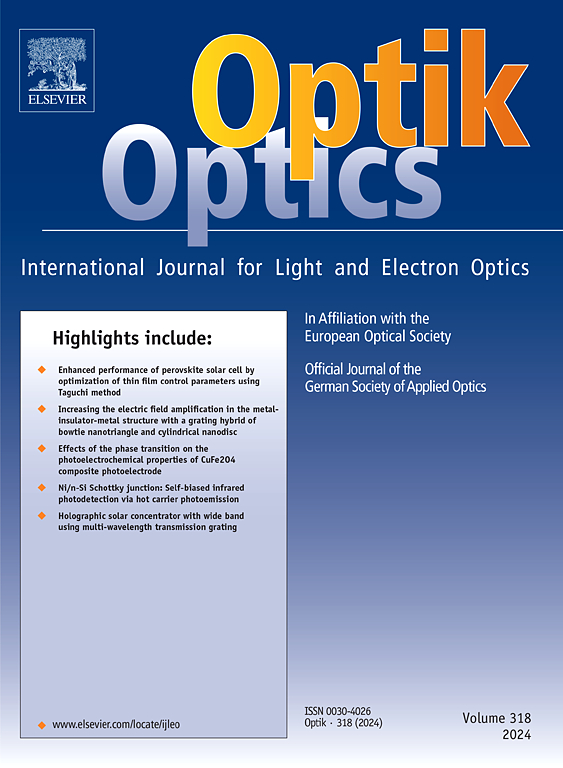先进的PCF-SPR生物传感器设计和使用机器学习技术的性能优化
IF 3.1
3区 物理与天体物理
Q2 Engineering
引用次数: 0
摘要
光子晶体光纤-表面等离子体共振(PCF-SPR)是一种先进的光学生物传感技术,利用专门的光纤来检测由分子相互作用引起的折射率(RI)变化。本研究提出了一种双核,金涂层PCF-SPR生物传感器,设计用于在分析物RIs范围为1.31至1.40和0.40 µm至0.90 µm的宽波长范围内工作,并集成了机器学习(ML)技术,以增强性能优化并提高预测准确性。利用COMSOL多物理场模拟器,我们从我们的新型传感器模型中生成了1868个样本的数据集。该传感器具有优异的性能,波长灵敏度(λ)高达9000 nm/RIU,振幅灵敏度(SA)为- 1141.93 RIU−1,分辨率(R)高达1.11 × 10−5 RIU。使用大量机器学习(ML)模型来预测关键参数,包括有效折射率(Neff)和约束损耗。其中,随机森林回归器(RFR)的r平方值为0.9997,最小平均绝对误差(MAE)为4.51 × 10 - 4,内夫预测的均方误差(MSE)为8 × 10 - 26。RFR在预测约束损失方面也具有较高的准确性。凭借其卓越的灵敏度和检测能力,所提出的传感器为生物应用提供了巨大的潜力。未来的工作将集成可解释人工智能(XAI)来识别关键特征,推动传感器性能和精度的进一步提高。本文章由计算机程序翻译,如有差异,请以英文原文为准。
Advanced PCF-SPR biosensor design and performance optimization using machine learning techniques
Photonic Crystal Fiber-Surface Plasmon Resonance (PCF-SPR) is an advanced optical biosensing technology that utilizes specialized fibers to detect refractive index (RI) changes caused by molecular interactions. This study proposed a dual-core, gold-coated PCF-SPR biosensor designed to operate across analyte RIs ranging from 1.31 to 1.40 and a broad wavelength range of 0.40 µm to 0.90 µm, with the integration of machine learning (ML) techniques to enhance performance optimization and improve predictive accuracy. Using the COMSOL Multiphysics Simulator, we generated a dataset of 1868 samples derived from our novel sensor model. The sensor achieved exceptional performance, reaching wavelength sensitivity (Sλ) of up to 9000 nm/RIU, amplitude sensitivity (SA) of −1141.93 RIU−1, and resolution (R) as high as 1.11 × 10−5 RIU. Numerous machine learning (ML) models were employed to predict key parameters, including the effective refractive index (Neff) and confinement loss. Among these, the Random Forest Regressor (RFR) achieved outstanding results, with an R-squared value of 0.9997, a minimal mean absolute error (MAE) of 4.51 × 10−4, and a mean squared error (MSE) of 8 × 10⁻⁶ for Neff prediction. RFR also excelled in superior accuracy in predicting confinement loss. With its exceptional sensitivity and detection capabilities, the proposed sensor offers significant potential for biological applications. Future work will integrate Explainable AI (XAI) to identify critical features, driving further advancements in sensor performance and precision.
求助全文
通过发布文献求助,成功后即可免费获取论文全文。
去求助
来源期刊

Optik
物理-光学
CiteScore
6.90
自引率
12.90%
发文量
1471
审稿时长
46 days
期刊介绍:
Optik publishes articles on all subjects related to light and electron optics and offers a survey on the state of research and technical development within the following fields:
Optics:
-Optics design, geometrical and beam optics, wave optics-
Optical and micro-optical components, diffractive optics, devices and systems-
Photoelectric and optoelectronic devices-
Optical properties of materials, nonlinear optics, wave propagation and transmission in homogeneous and inhomogeneous materials-
Information optics, image formation and processing, holographic techniques, microscopes and spectrometer techniques, and image analysis-
Optical testing and measuring techniques-
Optical communication and computing-
Physiological optics-
As well as other related topics.
 求助内容:
求助内容: 应助结果提醒方式:
应助结果提醒方式:


